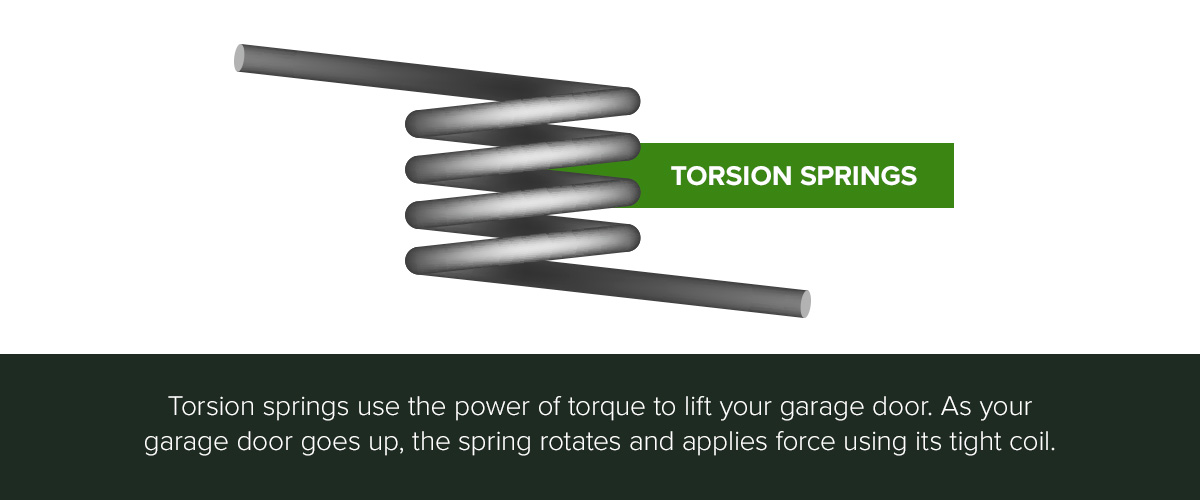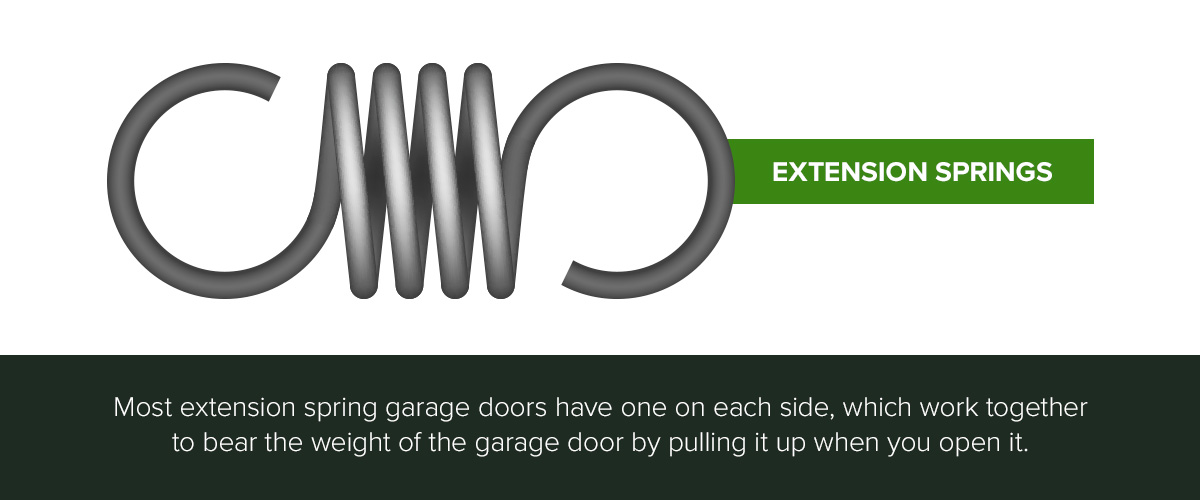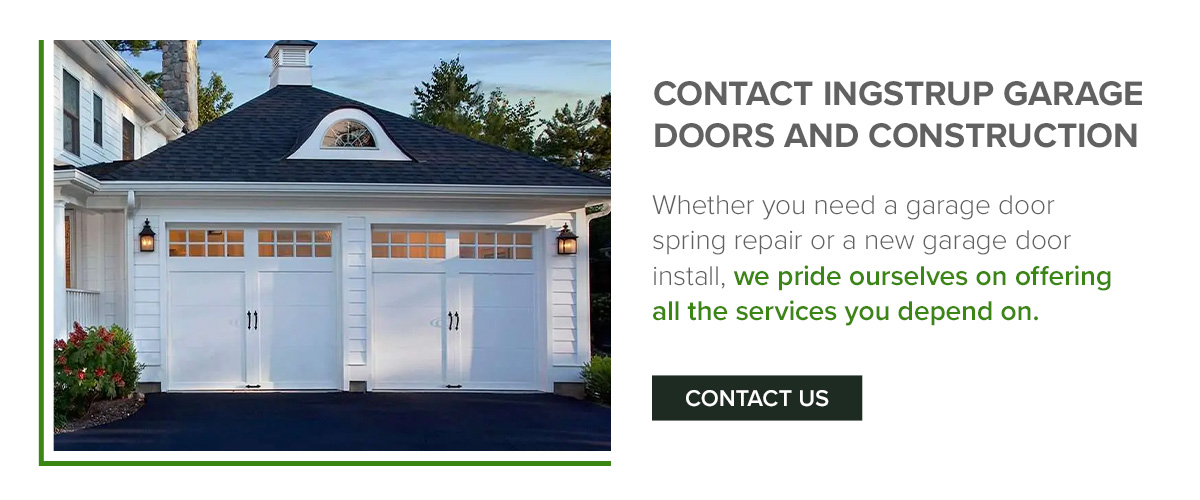When a garage door spring breaks, the loud sound that accompanies it can be frightening. After that, you’ll soon realize that your garage door has lost its functioning. Now, you have to think about repairing your overhead door springs, which might leave you with more questions than answers. The good news is that it’s repairable and that there is a garage door repair specialist near you who is ready to give you the help you need.
There are two different types of garage door springs for overhead rolling doors — torsion springs and extension springs. Here is the information you’re looking for on how they work, what their differences are and how to identify which kind you have. You can then give this information to your service technician before they arrive to ensure a smooth and fast repair.
What Are Garage Door Springs and What Do They Do for Garage Doors?
Garage door springs are heavy-duty springs that counterbalance the weight of your garage door. Your garage door is heavy, but these springs use their potential energy to help lift and lower your garage door. Even manual garage doors use springs to make the door feel much lighter than it actually is. They are part of the door, not part of the garage door opener.
One of the warning signs that your springs are broken is that your opener will be unable to move your garage door in either direction. While you may still be able to open the door with broken springs, it’s not advisable. Springs are one of the most essential parts of every garage door system, so you want to be sure to call a professional to make a repair right away. In the meantime, you can examine the situation to determine which kind of garage door spring your system uses.
 What Is the Difference Between Torsion Springs and Extension Springs?
What Is the Difference Between Torsion Springs and Extension Springs?
The first step to knowing what kind of spring you need is to know the difference between the two types of garage door springs, which are torsion and extension.
Torsion Springs
Torsion springs use the power of torque to lift your garage door. As your garage door goes up, the spring rotates and applies force using its tight coil. Torsion springs come in various sizes and numbers, and these factors correspond directly with the size and weight of your garage door.
Torsion springs require fewer additional parts to install than extension springs. This means you’ll enjoy less maintenance to keep them in good shape. The nature of torsion springs also allows them to open and close your garage door at a steady, smooth rate, giving you a better experience every time you use it.
There are three different types of torsion garage door springs:
1. EZ-Set Torsion Spring
These torsion springs are found in the middle section of the torsion shaft and can be used in both residential and commercial doors.
Clopay’s EZ-Set torsion springs are designed for the DIY (Do-It-Yourself) homeowners for easy and safe installation thanks to its ability to be wound by a drill.
2. Standard Torsion Spring
A standard torsion spring is found above the top of the door, usually right in the middle. The torsion shaft runs through the middle of this spring. It is used for both residential and commercial doors.
Generally, your door will have one or two torsion springs, but heavier doors could require up to four springs, also depending on the size of the door.
Standard torsion springs are the type of springs a professional would install. This is because EZ-Set torsion springs and TorqueMaster torsion springs use plastic parts which are more difficult to repair than standard torsion springs.
3. TorqueMaster Torsion Spring
This spring is encased inside the torsion shaft and is considered one of the safest spring types for residential garage doors.
Wayne Dalton’s TorqueMaster torsion spring, like Clopay’s EZ-Set torsion spring, doesn’t have to be wound and unwound by hand. You can adjust it with a drill. It stays in place with a winding cone that allows you to adjust the door safely and easily. These are also marketed towards homeowners who would consider themselves do-it-yourselfers.
Extension Springs
Extension springs are more like the traditional springs you may be familiar with. These springs expand and contract with the movement of the garage door. Most extension spring garage doors have one on each side, which work together to bear the weight of the garage door by pulling it up when you open it.
The length of your extension springs corresponds with the height of your garage door, so make sure you’re getting the right size. You should also know that professional installation of these springs also means installing additional parts like safety cables. These keep the springs contained if they break again in the future.
Most garage doors have two extension springs on either side of the door, lying parallel to the horizontal track. Each spring offers independent tension that affects the door’s functionality.
These garage door spring types have three different ends that offer unique pros and cons:
1. Open-Looped Ends
This extension spring doesn’t require disassembling the pulley or deconstructing the eyebolt, making it the easiest one to replace. However, if even a small part is damaged, you need to replace the entire spring.
2. Double-Looped Ends
This type has two coils that attach to the pulley and eyebolt and offer a stronger grip, but it can be more challenging to replace.
3. Clipped Ends
These extension springs are the standard for 200-pound or more doors as they offer unmatched durability. Thanks to the clips, which don’t put much stress on the springs, they also have a prolonged service life.
With any type of extension spring, you want to make sure that there is a containment cable that runs through the middle of the spring. This is because if the spring ever breaks, the containment cable keeps it from flying around the garage.
How To Identify Which Kind of Spring You Have
Now that you know more about the two types of garage door springs, it’s time to identify which kind you need to repair your garage door. Here are three ways to determine the best spring replacement:
- Look in the right locations: Your first step is to look in the right places to see which kind of spring your garage door uses. Springs that are directly above the garage door are torsion springs, and springs located to the left and right of the garage door along the roller tracks are extension springs.
- Check the end of the springs: Extension springs end in metal loops, while torsion springs end in special metal pieces called cones.
- Look for certain additional hardware: Extension springs connect to the pulley system via the metal loops on their ends. Torsion springs connect to a metal tube above the garage door that connects on either side to the drum and cable.
Should You Have One or Two Garage Door Springs?
Many people wonder if they should have more than one garage door spring. The answer depends on the type of garage door you have. Remember that extension springs always come in pairs, with one on each side along the roller tracks. Torsion spring garage doors can use any number of springs, however, we recommend two torsion springs on a door. This is because when the spring is wound up, it tends to pull in one direction. By having two springs, the pull in one direction will be distributed. Also, if one spring does break, you would still have half of your counterbalance weight. For example, if you have a 100-pound door and you break a spring, you’d only need to lift 50 lbs to get out in case of emergency.
The specifications of your torsion spring garage door will determine how many springs you need. Light, single-car garage doors may only need a single torsion spring. Two-car garage doors will often need two torsion springs to get the job done. However, the type of material and hardware used in your garage door will also affect how many you need. Heavy single-car garage doors may need two torsion springs, while heavy two-car garage doors may need four torsion springs to lift all that weight.
Remember, a garage door can only work with springs. The door will be far too heavy for your opener to lift without them. So make sure you have two functioning extension springs or at least one functioning torsion spring for your garage door system. Talk to your garage door professional to know how many torsion springs you need for your current system.
Is It a Good Idea to Replace Both Garage Door Springs at the Same Time?
Deciding whether to replace both springs at the same time depends on your garage door. If it requires two springs to roll up, then you’ll need to replace both springs, even if only one is faulty.
Most often, it’s a good idea to replace both springs since altering just one side can result in an imbalance. Of course, if you aren’t sure, you can always request an estimate, and an expert will help you.
How Long Will a Garage Door Spring Last?
Generally, a garage door spring lasts for approximately seven to 10 years. Most garage door springs that come directly from the manufacturer last for 10,000 cycles. Once cycle means moving the door all the way up and then bringing the door all the way back down one time.
If you went in and out of your garage door once a day (2 cycles) every day (365 days), it would be 730 cycles for just one driver. Usually, people go in and out of their garage more than once a day, so could round that up to 1,000 cycles per driver. If you have four people going in and out of the garage all the time, that’s 4,000 cycles in just one year. So, your garage door spring can go through 10,000 cycles quicker than you would think.
If you use your garage door more frequently, the wear and tear will cause the springs to deteriorate more quickly, and it may not hit the seven-year mark.
At Ingstrup Garage Doors, we offer lifetime warranty springs that can last for up to 150,000 cycles. If that spring breaks, we will return and replace it free of cost.
Which Garage Door Springs Are Best?
When it comes to torsion springs vs. extension springs for garage doors, torsion springs are the better option. The first reason is that torsion springs are safer. Due to the nature of extension springs, they can catapult into the air upon breaking. This can lead to damages to whatever is in your garage or injuries. When a torsion spring breaks, it will make a loud sound. But since it sits around a torsion tube, it stays put at the moment of breakage.
Another reason to choose torsion springs is their longer life span. With proper maintenance, a torsion spring system can last far longer than an extension spring system. This is because torsion springs offer superior balance to your garage door, which makes things much easier on your opener and ensures even pressure distributes across your torsion spring.
 Contact Ingstrup Garage Doors and Construction To Repair Your Garage Door
Contact Ingstrup Garage Doors and Construction To Repair Your Garage Door
It’s important to hire a professional if your door springs are broken. Trying to operate the broken door or fix it yourself can result in injury. If you’ve recently experienced a broken spring on your garage door, Ingstrup Garage Doors is here to help. We can find which garage door springs are best for your door and get it running smoothly again.
Our service areas include Lansing and Grand Rapids, Michigan, and we always welcome new requests for service. Whether you need a garage door spring repair or a new garage door install, we pride ourselves on offering all the services you depend on.
Contact us today for more information on how we can meet your needs!




